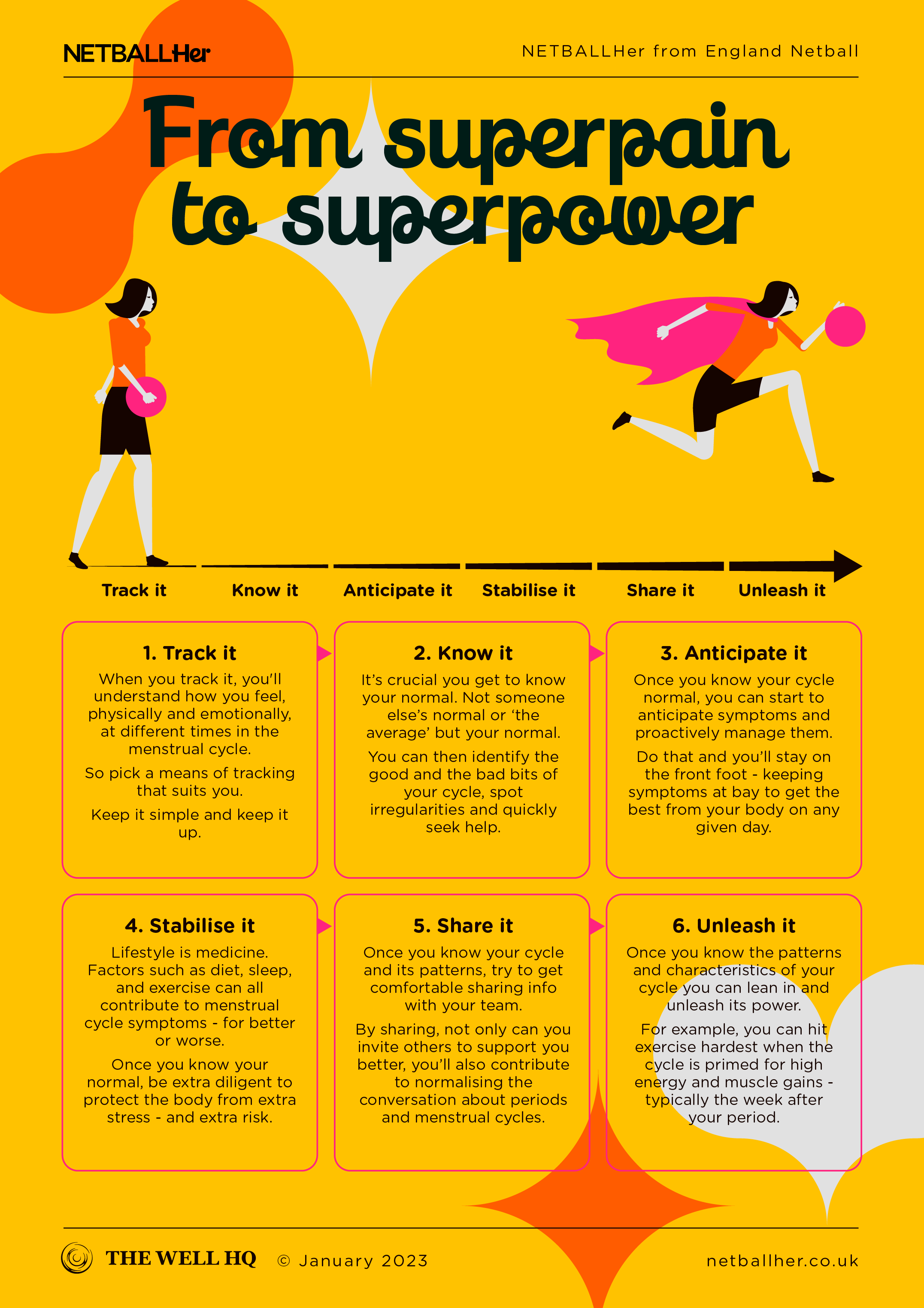Click play for an audio readthrough of this article
An amazing, beautiful, unique part of being female, the menstrual cycle may influence injury risk … but no-one says you’re not in control.
The menstrual cycle. It’s a pattern of hormonal fluctuation over roughly 28 days. It’s normal, it’s healthy and, despite the issues some women experience, it’s an amazing and beautiful part of being female.
But there’s a but. In recent days, academic and even newspaper articles have reported links between the menstrual cycle and injury.
The upshot of recent chatter is that some sportswomen say they’re nervous training or playing at certain times of their cycle. Others say they dial back or pause their training during such times and, in team sports, we’ve even heard of coaches selecting their starting team based on where female players are in their cycles.
But let’s slow down a second …
What we know
In no world should women be told general and catchall rules about when to worry or when (not) to move. From a data and research point of view we do not yet have a complete picture as to the relationship between the menstrual cycle and injury. Any day of your cycle is a good day to move, and research shows that important determinants of performance, like speed, power, and aerobic fitness, aren’t impacted by the hormones of your cycle.
That said, there is emerging evidence that certain times of the menstrual cycle may cause changes and adaptations in the body that can – without being known, appreciated or mitigated – increase certain risks.
So far, we don’t know if it’s the hormones themselves and the direct effects they may have on joints, ligaments, tendons and muscle, that might impact us, or the knock-on effects of how hormones make us feel (less coordinated, more inclined to take risk, or less sensitive to pain) which might see cycle-time as an injury factor.
There is evidence, from studies of large groups of female athletes across multiple seasons, that during the late follicular phase of the cycle, that’s the second week, injury prevalence is slightly higher than at other times.
The jury’s still out yet the goal for everyone hasn’t changed much. We should all try to understand our own experience of our own cycle. By understanding how our bodies feel at different phases / stages, we can work with what we know about ourselves … not with what research suggests is possible for others.
Oestrogen
If you need a reminder on all things menstrual cycle, click here. But for now, remember that the first day of your period is the first day of your cycle and oestrogen peaks in the second week – what’s called the follicular phase.
During the follicular phase, high oestrogen levels ensure more glucose is taken into your muscle fibres. In other words, oestrogen is firing on all cylinders and this will almost certainly boost your performance level, especially in high intensity training.
Oestrogen also accelerates muscle adaptations and recovery from injuries. It does this by multiplying and activating satellite cells – which can then develop into skeletal muscle cells – to speed up the repair job on any injuries, tears and traumas.
So far so awesome, but …
The above suggests that oestrogen is a guard against injury and it sort of is. After all, oestrogen boosts muscles and muscles are ground-zero-protection against injury. But oestrogen also has a negative effect on collagen and herein lies the risk.
Collagen is the main component of your connective tissues – your tendons and ligaments – and research suggests that oestrogen causes collagen to become more elastic. While a man’s joint laxity remains steady and constant, a woman’s increases by about 5mm in the late follicular phase of the cycle, when oestrogen is riding high.
So the punchline is that there may be an increased risk of joint injury during this time.
Some studies suggest that for every 1.3mm increase of laxity in a woman’s knee joints, the risk of anterior cruciate ligament (ACL) injury (a very painful and debilitating injury that takes a long time to heal) goes up fourfold.
Extra oestrogen, extra care
Yes, there’s a risk but let’s step back. Women don’t just start falling over because oestrogen is pumping. No one thing is ever solely responsible for an injury. Injuries are usually the result of several, multiple, dozens of different factors inside and outside the body.
Oestrogen is like anything else: the more you understand how it works for you, the more you can tune in, control it and harness its power. If you do your utmost to make yourself a strong, resilient, stable, coordinated and agile player, then you’ll likely minimise the risk of oestrogen influencing your joints. In short, your body will cope with this physiological change just fine provided you’ve done a good job of preparing it to do so.
To give your body a helping hand on that journey, try conditioning exercises three times a week as part of your warm up. The exercises presented in the Jump High, Land Strong programme, from England Netball, are a fabulous place to start.
Also, by tracking and tuning in to your menstrual cycle you can learn to spot patterns. We’ve worked with active women who noticed the same annoying injuries and symptoms – like lower back pains and tight hamstrings – were cropping up time and again and, through tracking, they were able to connect the pains to specific times in the cycle.
From there, instead of worrying about injuries, these active women were able to take ownership, lean in, and adapt their training accordingly. For some, it was as simple as doubling up on warm-up time, which is good advice for anyone during high-oestrogen times of the cycle.
Elsewhere in this section we expand on why women’s joints are more vulnerable in general than men’s (spoiler alert, it’s not about the menstrual cycle) so the guidance given on warm-ups, cool-downs, strength training and, crucially, developing a better and safer technique is forever advice.
All of the above is vital, risk-mitigating practice whether oestrogen is pumping or not.
Progesterone
Another quick reminder, progesterone is the more calming of the two key menstrual hormones. It peaks in the second half of the cycle and invites the body to focus on reducing pain, stress and anxiety.
Like oestrogen, progesterone has several wonderful properties that really benefit mind and body. But its focus on calmness and stress-reduction means it may be responsible for small changes in a woman’s skill and coordination.
There’s anecdotal evidence to support this. Our Dr Emma spoke with a hockey coach who claimed he could tell when his players were in this phase of their cycle, because they were “slightly off” in their ability to see and use time and space on the pitch.
Similarly, an archery coach mentioned how one athlete was more likely to be “slightly off” in her feel for the bow at this same time of the cycle.
Interesting that both coaches used the phrase “slightly off”, as if to say it’s nothing serious, but there was nonetheless an appreciable change. The word “slightly” doesn’t scream injury risk but, as said, injuries are multifactorial and any reduction in motor skill and coordination can play a part.
Once again, tuning into your unique menstrual cycle will allow you to see if and how high-progesterone phases impact you. You’ll be able to see repeating patterns, draw conclusions, and take action.
For example, we know caffeine can be useful to improve cognition and alertness. Ditto aerobic exercise. Exercises based on strong muscle contraction, skill and agility are particularly useful to enhance the signalling in your brain.
So once again it’s about action, not inaction. You can take control. If a quick coffee and an aerobic warm-up session can sufficiently fire up your neuromuscular system then perhaps you can over-ride (or at least dampen down) any cognition-altering side-effects of high progesterone.
Break the cycle of pain
The last injury risk symptom we’ll touch on regarding the menstrual cycle is a big one. It’s the general pain of symptoms, and the impact of said pain on one’s ability and / or motivation to train.
We know many women suffer period pain that range from sore to excruciating to downright debilitating. The more intense the pain, the more training days are in jeopardy.
Some quick maths and losing 3-5 days of training per month translates in up to 60 lost training days per year. That’s two whole months where a woman isn’t able to train (or at least not as she’d like) as a result of period pain. It’s an awful lot of lost time, no?
There’s no magic bullet to suddenly make period pains and symptoms disappear, but there are plenty of pain management strategies and you might be some trial-and-error away from finding yours.
Rather than repeat ourselves, we’ll direct you to this video and poster on period pain management …
And urge you, once again, to track your menstrual cycle so you can tune into your own unique patterns of pain so you can take action, and figure out ways to blunt the impact of your symptoms.
Often, managing period pains is a case of getting in front. Over-the-counter painkillers, paracetamol or ibuprofen, a day or two before pain starts may limit how bad it actually gets.
For those who suffer low-mood and motivation, solutions might be focusing on things you love or yoga or hot water bottles or vitamins or … there are tried and tested strategies out there, you simply have to find the unique method (or combination of methods) that’ll allow you to break your pain cycle.
The last word
The menstrual cycle is a unique part of you. No-one else in the world has the exact same menstrual cycle as you, and no-one else in the world is going to master your cycle. No-one else in the world is going to conquer the complexities of your pain and / or hormonal activity. It’s on you.
That’s why it’s such a worthwhile investment to tune into what’s uniquely yours. Track your menstrual cycle, join some dots, and you can figure out the right actions at the right time. It’ll help put the scary headlines into perspective.
Instead of hearing oestrogen = injury risk, you can think oestrogen = awesome (but I have to use it safely, especially in week two).
Instead of hearing progesterone = messes with my coordination, you can think progesterone = coffee time.
Instead of resigning to five lost training days every month due to period pain, you can strategise ways to turn five lost days into four, or maybe three, or perhaps in time just the one or two.
So for now it’s over to you. Happy tracking … and good luck on your journey of discovery.
As a reminder, the content of the course belongs to The Well HQ. You have permission to access and use the content yourself or, if you are an organisation, for the number of users selected, but are not otherwise permitted to share such content with others, all in accordance with our Course Terms and Conditions.

